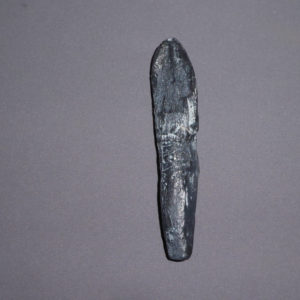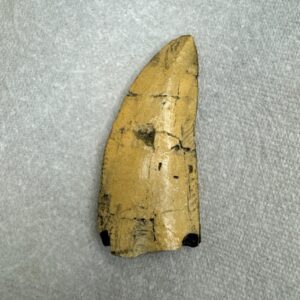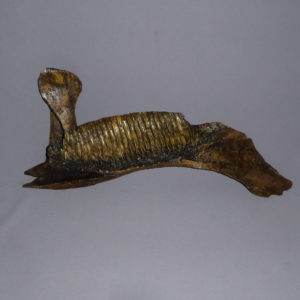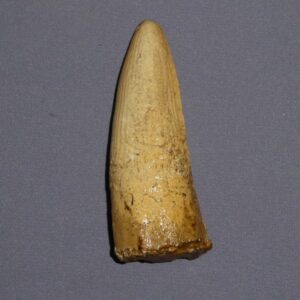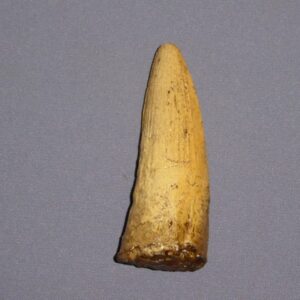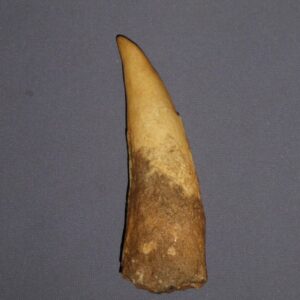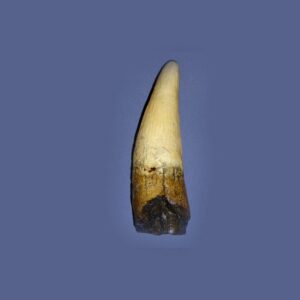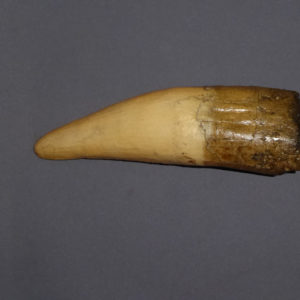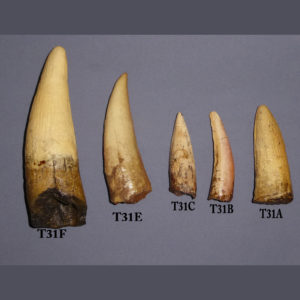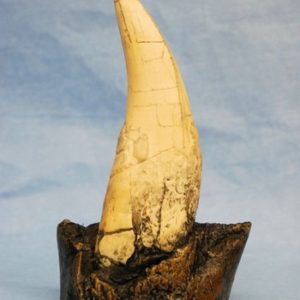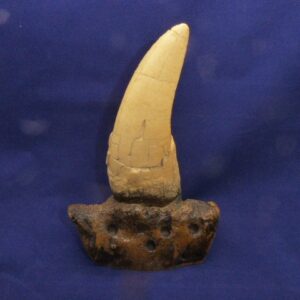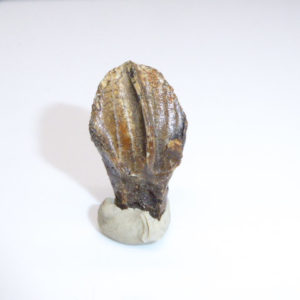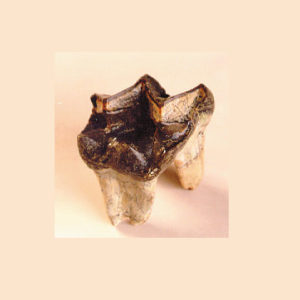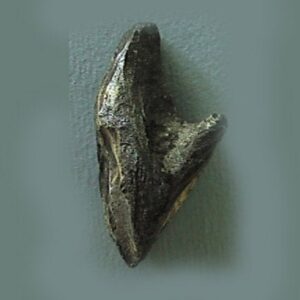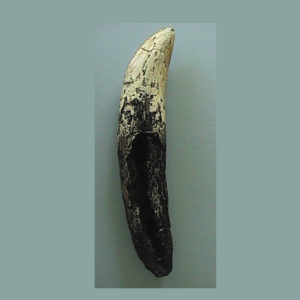All items sold on this website are polyurethane resin replicas, made in USA. No real or natural bone is available on this site.
Dinosaur Teeth Replicas are museum quality polyurethane resin castings made from real extinct dinosaurs. Dinosaur Teeth Replicas are made in USA.
Mary Ann Mantell and her husband Dr. Gideon Algernon Mantell discovered an Iguanodon tooth in Sussex in England which was studied for years.
Some of the most important information about dinosaur teeth is collected from polished, microscopically thin sections, including the types of dental tissues present, tooth wear, replacement patterns, and how the they are attached.
The most significant differences are in how the dinosaur teeth fit together and continually regrew.
Some examples of shedding old teeth and others reabsorbing older teeth as they would grind down under chewing throughout a dinosaurs life.
Dental histology has not been looked at in great detail of dinosaurs until more recently and there has been an increase in interest in this particular sub-field.
-
Albertosaurus Lower Jaw Fossil
$227.00The massive skull of Albertosaurus, which was perched on a muscular, short, S-shaped neck, was about 3.3 feet long in the largest adults. Wide openings in the skull provided space…
-
Albertosaurus Maxilla Fossil Replica
$239.00The massive skull of Albertosaurus, which was perched on a muscular, short, S-shaped neck, was about 3.3 feet long in the largest adults. Wide openings in the skull, called fenestrae,…
-
Camarasaurus Dinosaur Tooth Replica
$32.00The 7.5 in. teeth were shaped like chisels (spatulate) and arranged evenly along the jaw. The strength of the teeth indicates that Camarasaurus or Chambered lizard probably ate coarser plant…
-
Carcharodontosaur Tooth Replica
$28.00It had a large, lightly built skull with a triangular rostrum. Its jaws were lined with sharp, recurved, serrated teeth that bear striking resemblances to those of the great white…
-
Diprotodon Tooth Tusk Replica
$29.00Diprotodon (Ancient Greek: “two protruding front teeth”) is an extinct genus of marsupial from the Pleistocene of Australia containing one species, D. optatum. The earliest finds date to 1.77 million…
-
Duckbill Dinosaur Tooth Replica
$32.00The back of the mouth contained thousands of teeth suitable for grinding food before it was swallowed. This has been hypothesized to have been a crucial factor in the success…
-
-
Giganotosaurus Dinosaur Tooth Replica
$24.00The front of the lower jaw was flattened, and had a downwards projecting process (or “chin”) at the tip. The teeth were compressed sideways and had serrations.
-
Parasaurolophus Walkeri dentary
$121.00Parasaurolophus Walkeri or Cyrtocristatus was a hadrosaurid, part of a diverse family of Cretaceous dinosaurs known for their range of bizarre head adornments.
-
Spinosaurus Tooth Fossil A
$19.00Unlike many meat-eating dinosaurs that had serrated, knife-like teeth the teeth of Spinosaurus were smooth and conical. Their teeth looked much like the teeth of crocodiles and their upper and…
-
Spinosaurus Tooth Fossil B
$22.00Unlike many meat-eating dinosaurs that had serrated, knife-like teeth the teeth of Spinosaurus were smooth and conical. Their teeth looked much like the teeth of crocodiles and their upper and…
-
Spinosaurus Tooth Fossil C
$22.00Unlike many meat-eating dinosaurs that had serrated, knife-like teeth the teeth of Spinosaurus were smooth and conical. Their teeth looked much like the teeth of crocodiles and their upper and…
-
Spinosaurus Tooth Fossil E
$27.00Spinosaurus aegyptiacus is known to have eaten fish, and most scientists believe that it hunted both terrestrial and aquatic prey; evidence suggests that this extinct dinosaur lived both on land…
-
Spinosaurus Tooth Replica F
$27.00Unlike many meat-eating dinosaurs that had serrated, knife-like teeth the teeth of Spinosaurus were smooth and conical. Their teeth looked much like the teeth of crocodiles and their upper and…
-
Spinosaurus Tooth Fossil Replicas
$89.00Unlike many meat-eating dinosaurs that had serrated, knife-like teeth the teeth of Spinosaurus were smooth and conical. Their teeth looked much like the teeth of crocodiles and their upper and…
-
T-Rex Dinosaur Tooth Replica
$29.00Tyrannosaurus rex holds the record for the longest tooth at 12 inches. T. rex had 50 to 60 thick, conical, and serrated teeth that were replaced after being broken, and…
-
Tenontosaurus Dinosaur Tooth
$27.00Tenontosaurus had a long, flexible neck. The front of its mouth had no teeth; it had a horny beak for biting off plants. Rows of strong, tightly fitted teeth ground…
-
Titanothere Fossil Tooth Replica
$22.00The Brontotheres or Titanotheres, are a completely extinct group of perissodactyls that had elongated skulls with shortened faces and a unique pattern of w-shaped ridges on their upper molar teeth.
-
-
Tyrannosaurs Rex Tooth Large
$25.00Tyrannosaurus rex holds the record for the longest tooth at 12 inches. T. rex had 50 to 60 thick, conical, and serrated teeth that were replaced after being broken, and…
-
Tyrannosaurus Dinosaur Tooth Replica
$35.00Tyrannosaurus rex holds the record for the longest tooth at 12 inches. T. rex had 50 to 60 thick, conical, and serrated teeth that were replaced after being broken, and…
-
Tyrannosaurus Rex Maxilla Replica
$452.00Tyrannosaurus rex possesses a heterodont dentition composed of three classes (premaxillary, maxillary, and dentary) and several sets. The maxilla contains mesial and distal sets and the dentary contains first dentary…
-
Tyrannosaurus Rex Tooth Baby
$18.00Tyrannosaurus rex holds the record for the longest tooth at 12 inches. T. rex had 50 to 60 thick, conical, and serrated teeth that were replaced after being broken, and…
-
Tyrannosaurus Rex Tooth Medium
$25.00Tyrannosaurus rex holds the record for the longest tooth at 12 inches. T. rex had 50 to 60 thick, conical, and serrated teeth that were replaced after being broken, and…



